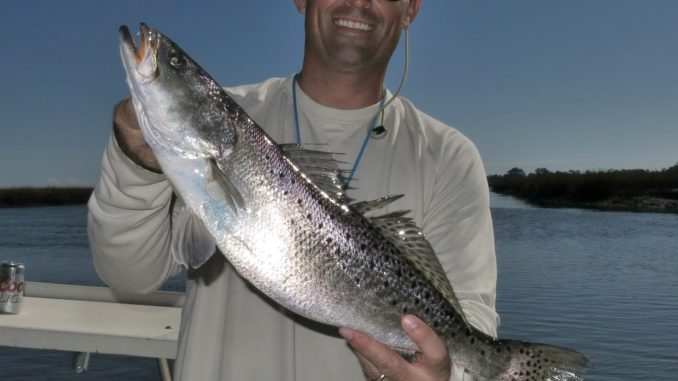
Southerly migration of white shrimp kicks off big trout bite along South Carolina coast.
For light-tackle anglers along the southern tip of the Grand Strand, the arrival of fall is nothing less than an early Christmas present. Fishermen around Murrells Inlet welcome along with October the prime season for catching speckled trout. From the rock-lined jetties on the ocean side to the handful of oyster-covered creeks in this quaint vacation destination, the speck showcase showdown begins.
While trout may not show up on as many bumper stickers or Guy Harvey t-shirts like their spot-tailed neighbors, these speckled delights have a huge following for their tasty flesh, feisty battles and, best of all, their abundance.
Speckled trout live in a variety of habitats throughout the year, but they will quickly shift and sometimes migrate great distances to find their happy medium. While redfish and flounder can tolerate a wide range of temperatures, specks are often referred to as “winter trout” and are very sensitive to water temperature on both ends of the spectrum.
When the water is too hot, they seek out deep-water refuges in estuaries or migrate to cooler climates along the ocean highway. During the fall, dropping water temperatures trigger a chain reaction and migratory response from the baitfish and shrimp fleet that quickly draws speckled trout into South Carolina’s estuaries for a massive feeding frenzy.
Capt. Jason Burton of Fly Girl Fishing Charters gets just as fired up as the speckled trout do when October begins and the first few cool weather blasts arrive. According to Burton, the fall speckled trout flurry is directly related with the migration of white shrimp.
“At the end of September and the beginning of October, mullet are on their way out, and the shrimp migration is in full force,” said Burton (843-421-2870). “Shrimp migrate from north to south in the fall and on their migration route, they can duck inside the inlet to feed and hide from predators.”
Even though speckled trout will eat a wide variety of things, plump and juicy shrimp are caviar for ol’ yellowmouth. The shrimp migration attracts large groups of trout into the vicinity of Murrells Inlet and other coastal estuaries.
“The constant influx of shrimp moving in and out of the inlet gets the trout fired up. It’s lunchtime for them,” said Burton.
Burton often begins his October charters at the jetties, which provide perfect habitat for shrimp and baitfish to hide, along with a good feeding opportunity for a wide assortment of predators. While the jetties look appealing from just about every angle, Burton chooses certain places for his fall specks.
“Outside of the north jetty is generally the best place to catch trout in the fall. The jetties deflect the flow of water, and wads of shrimp migrating down the beach that creates a perfect ambush point for trout,” said Burton.
But the jetties are not the only places to encounter the shrimp flow or schools of feisty specks. Plenty of shrimp pour into the Murrells Inlet estuary into the main creeks and even up a few of the smaller tidal runs that lead well up into the marsh. Inside the inlet, Burton looks for the deeper places lined with oyster shells not too far from the inlet.
“Trout are ambush feeders, and the dramatic depth changes create perfect ambush points for trout and we have plenty of those in Murrell’s Inlet,” he said.
Capt. J Baisch of Fishfull Thinking Guide Service said October through December is his favorite time to fish Murrells Inlet because of the big, fat trout that show up.
“In Murrell’s Inlet, we get bigger fish than they do in Georgetown this time of year,” said Baisch (843-902-0356). “Our trout eat tons and tons of big shrimp, and they will be at the jetties, oyster bars, creek channels and even some sand flats on high tide; really about anywhere.”
When trout move into Murrells Inlet to feed, they’ll show up in places where they can eat as much as possible.
“Anywhere there is a good ambush point, they will be there. I usually always start at the jetties and then move inside,” Baisch said.
Since trout like to ambush their prey, current can be a controlling factor; Baisch prefers an incoming tide at both the jetties and at his inshore spots. For Burton, higher, moving water makes for a perfect setup for catching fall trout.
“From mid-tide to high tide and then an hour of the falling tide are my favorite tides to fish. The higher the tide the better,” he said.
Since speckled trout are eating shrimp by the pound this month, live shrimp are the best and most-effective baits, and Baisch and Burton never leave the dock without a tank full of shrimp.
“I float live shrimp 2 to 3 feet above the bottom using a slide float. I keep varying the depth until we find them,” said Baisch, who will drift main creek channels with live shrimp and stop at oyster bars to cast artificial shrimp past ambush spots on either side of the oysters.
On the inside, Baisch will drift the main creek channels with live shrimp. Additionally, he will stop at the oyster bars and pitch a Berkley Power Grub on a 3/8-ounce or smaller jighead in opening night or electric chicken colors to ambush spots on each side of the oysters.
Burton will cast traditional jig-and-grub combinations and some 52M MirrOlures, but over the past few years, his preference has changed as more artificial shrimp have become available.
“The trout are hungry in the fall and will eat about anything, but artificial shrimp like the 3-inch Vudu shrimp are hard to beat when the trout are already targeting shrimp,” said Burton, who uses a variety of colors: natural, chartreuse, pearl, gold and magic. “Trout are reaction feeders, and they just will not let a shrimp pass by when they are hungry.”
When his schedule allows him to hit the water early, Burton will rig up a clear Zara Spook and cast along the oyster bars near the deeper channels.
“It is usually only the first 45 minutes of daylight, but the topwater action in October can be fantastic in Murrells Inlet,” he said.
With big numbers of fish and some trophy specimens showing up around Murrells Inlet, October begins a time like none other for fishermen who target specks. So grab a bucket of live shrimp and pick out a few tempting artificial lures for some of the best action available.
DESTINATION INFORMATION
HOW TO GET THERE/WHEN TO GO — Murrells Inlet is at the southern tip of the Grand Strand, easily accessible from the public boat ramp on US 17 Business, just south of the heart of Murrell’s Inlet’s famous restaurant district. Speckled trout cranks up in October and can remain good through December, depending on how long the water temperature remains in the high 50s. The second half of October through Thanksgiving is usually the peak of the fall speck run.
WHERE TO GO/BEST BAITS — Murrells Inlet’s estuary is not too extensive, so you’re never far from places to catch trout. The rock jetties at the inlet’s entrance are great, and trout pour into Oaks Creek, Garden City Creek and other smaller creeks in the estuary. Look for spots near deep water with a good current flow, plus abrupt depth changes around creek channels with oyster shells or jetty rocks. Trout will often set up on both the deep and shallow sides of structure. Live shrimp fished under a sliding or popping cork is tremendously effective; fish the shrimp 2 to 3 feet off the bottom. Artificial shrimp — Vudu, D.O.A. and Gulp! are popular varieties — can be fished under a popping cork in shallow water or free-lined to work closer to the bottom with a very slow, stop-and-go retrieve. They can also be threaded on light jigheads and cast or trolled. Higher stages of the tide are preferred.
TACKLE/GEAR — Medium-light to medium action baitcasting and spinning gear will perform well on trout. Use 6 ½- to 7-foot rods mated with reels spooled with 10- to 14-pound braided lines. In addition to braided line, a 15- to 24-inch section of 14- to 20-pound fluorocarbon leader should be tied on between the lure and the main line.
FISHING INFO/GUIDES — Capt. Jason Burton, Fly Girl Fishing Charters, 843-798-9100; Capt. J Baisch, Fishfull Thinking Guide Service, 843-902-0356; Perry’s Bait & Tackle, 843-651-2895; Pawley’s Island Outdoors, 843-979-4666. See also Guides and Charters in Classifieds.
MAPS — Navionics, 800-848-5896, www.navionics.com; Waterproof Charts Nearshore No. 98, 800-423-9026, www.waterproofcharts.com; SeaLake Fishing Guides, 800-411-0185, www.sealakeusa.com.
ACCOMMODATIONS — Hampton Inn, Murrells Inlet, 843-651-6687; Myrtle Beach Area Convention and Visitors Bureau, www.visitmyrtlebeach.com; South Carolina Association of Visitors Bureaus, www.discoversouthcarolina.com.

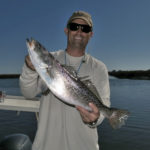
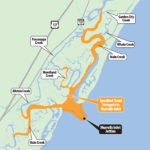
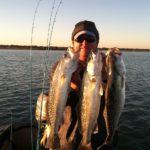
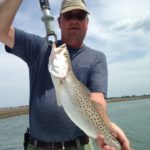



Be the first to comment